Pumps and Systems Success Story of the Year 2010 Winner
When a component of a large circulating water pump fails in a power plant, the power plant must often spend hundreds of thousands of dollars to remove the pump from service, replace the failed component, rebuild the pump and return it to service. In addition, circulating water pumps can require work on a massive scale-they can measure 30 ft or more in length and pump an average of 165,000 gpm. Rotating shafts for these pumps can measure 8 to 10 in. in diameter.
One major East Coast nuclear power producer was looking for a way to extend the life of the bearings in its circulating water pumps beyond the average 2.5 to 3 years service life it was experiencing with its current solution. It was looking for a solution that would significantly reduce the financial and logistical challenges associated with frequent servicing of its enormous pumps.
The Problem
The industry standard for vertical pumps has been to use hydrodynamic bearings with rubber lining. Unfortunately, rubber has poor lubricity and causes degradation to the shaft and bearings. In the power plant, brackish intake water containing silt and sand drastically shortened the life of rubber cutlass bearings in the circulating water pumps. In addition to having an average MTBF of 2.5 years, the bearings had larger than ideal running clearances. Initially, installation clearances were 0.023 to 0.025 in., and some clearances were five times the initial values (.020 to .025 in.) at the end of the operating cycle.
According to Greene, Tweed sales engineer Matthew Palucci, the combination of embedded particulates in the rubber and natural rubber swelling would significantly damage the mating shaft/sleeve surface and the rubber cutlass bearings. The increased running clearances that resulted could cause pump vibration and the increased likelihood of failure of other pump elements (seals, impellers, etc.).
If a rubber cutlass bearing continued to run with increased running clearances, it could delaminate from the I.D. of the bearing housing and then catastrophically fail.
Palucci explains that in another possible failure scenario, the glue holding the rubber cutlass in the bearing housing occasionally failed, causing delamination.
When the bearings failed, the costs exceeded $150,000 to pull a circulating pump from service and totaled approximately $200,000 to rebuild it.
To reduce these costs, the power producer looked for a bearing solution that would provide an ideal service life of five years. The new bearings had to withstand the brackish water and its inherent abrasives-sand, silt and phragmite (dead river grass/vegetation).
Solution
After testing out various bearing materials for abrasion resistance and dry run capabilities, the team at Greene, Tweed presented its AR-1 carbon/ thermoplastic composite bearings as a solution. The carbon thermoplastic composite material offered abrasion resistance, non-gall properties and chemical resistance approaching PTFE. It is rated from -100 deg F to 120 deg F (49 deg C).
In addition, AR-1's non-gall/non-seize properties helped avoid pump failures from excessive vibration or dry-run start-up. According to Palucci, "In a Greene, Tweed two minute dry run test, the rubber cutlass bearing started to smoke at the 20 second mark while the AR1 bearing survived the test with no degradation."
This non-gall feature of the AR-1 material permits running clearances to be reduced, enabling the large circulating water pumps to achieve .015. Some plant engineers take advantage of this reduced running clearance capability of the AR-1 while being conscious of stack height tolerances.
When installing the AR-1 bearings, Greene, Tweed engineers removed the rubber cutlass from the existing bearing liner. The bearing housing was then cleaned and prepped for the AR-1 insertion. If no shoulder was present in the bearing liner, one was machined into it, and the AR-1 was pressed-fit into the liner and either secured with axial tapered-head screws or radial pins. In this way, the bearing was securely fitted, and the end result was no possibility of it coming loose.
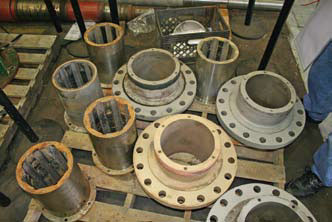
Disassembled flanged bearing housings with failed rubber cutlass bearings removed.
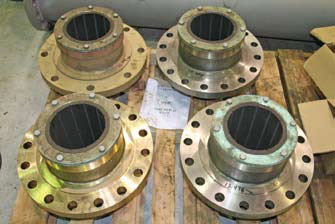
AR-1 bearings installed in flanged bearing housings.
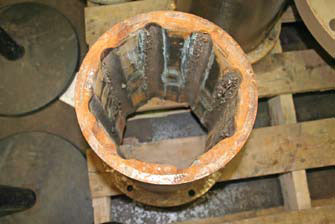
Close-up of failed rubber cutlass bearing.
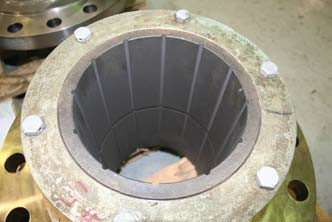
AR-1 axial fluted and pinned bearing inside flanged bearing housing.
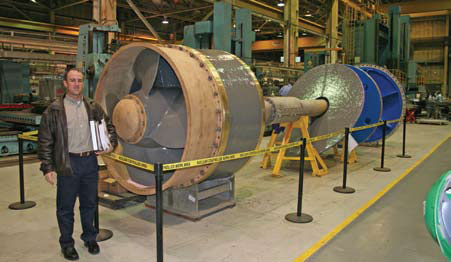
Axial view of pump internals from the suction bell (bottom) up past the diffuser to the drive coupling (top). The five AR-1 bearings are situated along the shaft.
Results
Greene, Tweed's solution has provided the power producer with dramatically longer bearing MTBM. The service life of the bearings has already exceeded the promised five years.
Upgrading seven pumps with the new bearing material has saved the power producer $1,575,000 to $2,100,000-$1,000,000 to $1,500,000 was saved in reduced pump overhaul cost, and maintenance expenses were reduced by $500,000 to $1,000,000. The power producer is currently using these successful results to address other pump groups within the plant.
Pumps and Systems, July 2010

